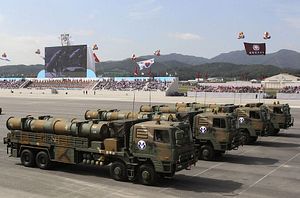The South Korean military is mulling test firing a ballistic missile in response to North Korea’s recent missile test, a military official told Yonhap News Agency.
“In response to North Korea’s missile launch Sunday, we are reviewing measures to discard security concerns and show our determination to retaliate against any aggression by the North,” he said.
According to the military official, the South Korean government is considering test launching missiles of the Hyunmoo (현무, which literally means “Guardian of the Northern Sky”) missile family, including the Hyunmoo 2A and 2B ballistic missile.
The Hyunmoo 2A is a surface-to-surface missile with an estimated range of 300 kilometers. The more advanced Hyunmoo 2B has an estimated maximum range of 500 kilometers (310 miles) and is capable of carrying a payload of up of up to 997 kilograms (2,200 pounds). The Hyunmoo 2B was last test fired in June 2015. As I noted previously (See: “South Korea Tests New Ballistic Missile”):
Ever since 2012, Seoul has been developing a new ballistic missile after the United States and South Korea concluded an agreement to extend the range of those weapons by up to 800 kilometers (about 500 miles) and carry warheads heavier than the pre-2012 limit of 500kg (1,102 pounds).
However, the agreement stipulates that the payload of missiles with a 500-mile range is limited to 1,100 pounds or below, in order to avoid a regional missile arms race with South Korea’s neighbors – China and Japan (shorter range ballistic missiles can carry up to 4,400 pounds under the rules).
The state-run Agency for Defense Development (ADD) is purportedly also working on a new longer range ballistic missile, which also could be test launched in due time. “There is also an opinion in the military that it will be more effective to unveil the test-firing scene of a new 800 km ballistic missile, which is in the final stage of development,” the military official said.
South Korea could also test fire a submarine-launched ballistic missile, which has been under development by the ADD for some time and allegedly has been specifically designed for Republic of Korea Navy KSS-III (aka Jangbogo III)-class diesel-electric attack submarines (See: “South Korea to Develop Submarine Launched Ballistic Missile”).
Ballistic and cruise missiles (e.g, the Hyunmoo 3B and 3C surface-to-surface cruise missiles, with an estimated range of 1,000 and 1,500 kilometers respectively) play a pivotal role in South Korea’s deterrence strategy, known as the Korea Massive Punishment & Retaliation (KMPR) plan vis-à-vis the North. In the event of a North Korean nuclear attack (or even signs of preparations for one), KMPR specifically calls for surgical strikes against key leadership figures of the communist regime and military infrastructure with the missiles part of a so-called kill chain consisting of integrated information, surveillance, and strike systems, as well as the Korea Air and Missile Defense (KAMD) system.
“In March [2016], the United States and South Korea held a large-scale military exercise that involved the execution of the so-called OPLAN 5015, a classified war plan signed last year that includes surgical strikes against North Korea’s nuclear, missile, and command and control facilities. This plan is part of KMPR,” I noted elsewhere. Furthermore, I reported previously, the United States and South Korea last conducted a long-range strike exercises against simulated North Korean targets in October 2016 to improve the strike capabilities of the United States Navy and Republic of Korea Navy ship-to-ground missiles.

































